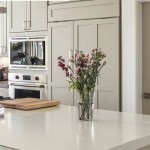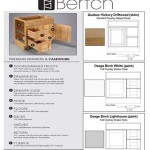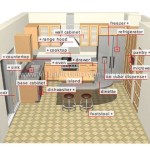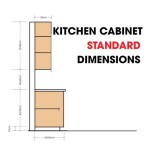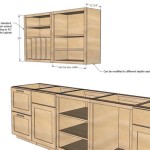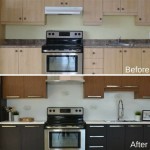How to Clean Grime Off Wooden Kitchen Cabinets
Wooden kitchen cabinets, while aesthetically pleasing, are notorious for accumulating grime, grease, and cooking residue. Regular cleaning is crucial to maintain their appearance and prolong their lifespan. Ignoring this task can lead to stubborn stains and damage to the wood finish, ultimately requiring costly repairs or replacements. This article provides a comprehensive guide on effectively removing grime from wooden kitchen cabinets using various methods and cleaning solutions.
Before commencing any cleaning process, it is essential to identify the type of finish on the wooden cabinets. Common finishes include polyurethane, varnish, lacquer, and painted surfaces. Understanding the finish is vital because certain cleaning agents can react negatively, causing discoloration, peeling, or dissolving of the finish. A simple test can be performed in an inconspicuous area, such as the cabinet interior or behind a door, to assess the compatibility of the chosen cleaning solution.
This test involves applying a small amount of the cleaning solution to the area and observing for any adverse reactions over a period of 15-30 minutes. If no damage or discoloration is observed, the cleaning solution is generally safe for use on the entire cabinet surface. Conversely, if any adverse reaction is noted, alternative cleaning methods should be explored.
Gathering the necessary supplies is the next crucial step. Essential items include microfiber cloths, warm water, mild dish soap, a soft-bristled brush (such as a toothbrush), baking soda, white vinegar, vegetable oil, and a spray bottle. Protective gear, such as gloves, is recommended to prevent skin irritation from prolonged exposure to cleaning agents.
Microfiber cloths are preferred due to their non-abrasive nature, which minimizes the risk of scratching the cabinet finish. A soft-bristled brush is useful for reaching tight corners and crevices where grime tends to accumulate. The choice of cleaning solution will depend on the severity of the grime and the type of cabinet finish.
Key Point 1: Gentle Cleaning with Soap and Water
The first approach to removing grime involves using a mild solution of dish soap and warm water. This method is effective for removing light grime and everyday spills. Mix a few drops of dish soap into a basin of warm water, creating a sudsy solution. Dip a microfiber cloth into the solution, wring out excess water, and gently wipe down the cabinet surfaces.
It is important to avoid using excessive water, as this can seep into the wood and cause damage. Focus on wiping in the direction of the wood grain to prevent streaks. Rinse the microfiber cloth frequently with clean water to remove any accumulated grime. After wiping down the cabinets with the soapy solution, use a clean, damp microfiber cloth to rinse off any soap residue. Finally, dry the cabinets with a clean, dry microfiber cloth.
For areas with stubborn grime, allow the soapy solution to sit on the affected area for a few minutes before wiping it away. This allows the soap to penetrate the grime and loosen it for easier removal. Avoid using abrasive sponges or scouring pads, as these can scratch the cabinet finish.
This method is generally safe for most cabinet finishes, but it is still recommended to perform a spot test before cleaning the entire cabinet surface.
Key Point 2: Using Baking Soda Paste for Stubborn Grime
For tougher grime and grease buildup, a baking soda paste can be used as a more abrasive cleaning agent. Baking soda is a mild abrasive that can effectively remove stubborn stains without causing significant damage to the cabinet finish. To create the paste, mix baking soda with a small amount of water until a thick, spreadable consistency is achieved.
Apply the baking soda paste to the affected areas of the cabinet using a clean microfiber cloth or a soft-bristled brush. Gently scrub the paste onto the grime, using circular motions. Allow the paste to sit on the grime for a few minutes to allow it to penetrate and loosen the buildup. After a few minutes, wipe away the paste with a damp microfiber cloth. Rinse the area thoroughly with clean water to remove any remaining baking soda residue.
Dry the cabinets with a clean, dry microfiber cloth. Baking soda can be slightly abrasive, especially on delicate finishes. Therefore, it is crucial to use gentle pressure when scrubbing and to perform a spot test before applying the paste to the entire cabinet surface. This method is particularly effective for removing grease splatters and food stains.
It is also important to note that while baking soda is generally safe, prolonged exposure to moisture can damage wood. Ensure that the cabinets are thoroughly dried after cleaning with the baking soda paste.
Key Point 3: White Vinegar Solution for Grease Removal
White vinegar is an excellent natural degreaser and can be used to effectively remove grease and grime from wooden kitchen cabinets. Its acidic properties help to break down grease and oil, making it easier to wipe away. To create a vinegar solution, mix equal parts white vinegar and warm water in a spray bottle.
Spray the vinegar solution onto the affected areas of the cabinets, focusing on areas with heavy grease buildup. Allow the solution to sit for a few minutes to allow the vinegar to penetrate the grease. Wipe the cabinets with a clean, damp microfiber cloth. Rinse the cloth frequently with clean water to remove any accumulated grease and vinegar residue.
Dry the cabinets with a clean, dry microfiber cloth. The vinegar smell may be noticeable at first, but it will dissipate quickly as the cabinets dry. For heavily soiled areas, the vinegar solution can be left on for a longer period of time before wiping it away. However, it is important to avoid leaving the solution on for too long, as the acidity can potentially damage the cabinet finish.
Vinegar is generally safe for most cabinet finishes, but it is still recommended to perform a spot test before cleaning the entire cabinet surface. Some individuals may find the smell of vinegar unpleasant. In such cases, adding a few drops of essential oil, such as lemon or lavender, to the solution can help to mask the odor.
Another helpful tip is to use a soft toothbrush to reach into the grooves and crevices of the cabinets. These areas are often overlooked during regular cleaning, and grime can accumulate over time. Dip the toothbrush into the cleaning solution and gently scrub the affected areas. Wipe away any residue with a clean, damp microfiber cloth.
Maintaining a consistent cleaning schedule is crucial for preventing grime from accumulating on wooden kitchen cabinets. Regular cleaning, even just a quick wipe-down once a week, can significantly reduce the amount of time and effort required to remove tough stains and grease buildup. Incorporating cleaning into your regular kitchen routine will help to keep your cabinets looking their best for years to come.
One preventative measure to consider is the strategic placement of protective barriers. Placing mats or rugs near the sink and stovetop can help to absorb spills and splatters, preventing them from reaching the cabinets. Additionally, using a range hood or exhaust fan while cooking can help to vent steam and grease, reducing the amount of airborne residue that settles on the cabinets.
Cleaning the hardware, such as knobs and pulls, is another important aspect of maintaining the appearance of wooden kitchen cabinets. Over time, hardware can accumulate dirt, grease, and fingerprints. To clean the hardware, remove it from the cabinets and soak it in a solution of warm water and dish soap. Scrub the hardware with a soft-bristled brush to remove any grime. Rinse the hardware thoroughly with clean water and dry it with a clean cloth before reattaching it to the cabinets.
If the hardware is heavily tarnished or corroded, a metal polish can be used to restore its shine. Follow the instructions on the metal polish carefully and test it in an inconspicuous area first to ensure that it does not damage the finish. Always remember to wear gloves when using metal polish to protect your skin.
Addressing mold and mildew is another issue that may arise, particularly in humid environments. If mold or mildew is present on the cabinets, a solution of bleach and water can be used to kill the spores. Mix one part bleach with ten parts water in a spray bottle. Spray the solution onto the affected areas and allow it to sit for a few minutes. Wipe away the solution with a clean, damp microfiber cloth. Rinse the area thoroughly with clean water and dry it completely.
When using bleach, it is essential to wear gloves and eye protection to prevent skin and eye irritation. Ensure that the area is well-ventilated to avoid inhaling fumes. Bleach can also discolor certain cabinet finishes, so it is important to perform a spot test before applying it to the entire cabinet surface. If bleach is not suitable, consider using a commercially available mold and mildew remover specifically designed for wood surfaces.
Finally, consider applying a protective coating to the cabinets after cleaning to help repel dirt and grime. Products such as furniture polish or wax can create a barrier that makes it easier to clean up spills and prevent stains from setting in. Follow the instructions on the product label carefully and test it in an inconspicuous area first to ensure that it is compatible with the cabinet finish.
Ultimately, the best approach to cleaning grime off wooden kitchen cabinets is a combination of regular maintenance, appropriate cleaning solutions, and careful attention to detail. By following the guidelines outlined in this article, individuals can effectively remove grime and maintain the beauty and longevity of their wooden kitchen cabinets.

How To Clean Kitchen Cabinets Everyday Skate

Get Grease Off Kitchen Cabinets Easy And Naturally

We Tried 5 Methods To Clean Greasy Wood Cabinets And The Winner Is Ridiculously Effective Kitchn Cleaning Kitchen

Best 4 Ways To Clean Greasy Kitchen Cabinets Rosene Toronto On

Get Grease Off Kitchen Cabinets Easy And Naturally

How To Clean Grimy Kitchen Cabinets With 2 Ingredients

How To Quickly Clean Cabinets Remove Grease Gunk Andrea Jean

How To Clean Painted Kitchen Cabinets By Kayla Payne

How To Remove Grease From Kitchen Cabinets Today S Homeowner

How To Remove Grease From Kitchen Cabinets 3 Methods Bob Vila

